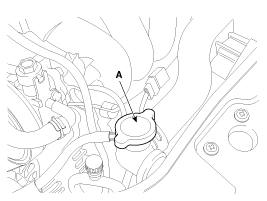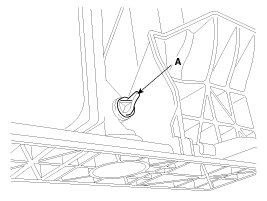 Kia Optima: Coolant. Repair procedures
Kia Optima: Coolant. Repair procedures
Refilling And Bleeding
|
Never remove the radiator cap when the engine is hot. Serious scalding could
be caused by hot fluid under high pressure escaping from the radiator. |
|
When pouring engine coolant, be sure to shut the relay box lid and not to
let coolant spill on the electrical parts or the paint. If any coolant spills,
rinse it off immediately. |
| 1. |
Make sure the engine and radiator
are cool to the touch. |
| 2. |
Remove radiator cap (A).

|
| 3. |
Loosen the drain plug (A), and
drain the coolant.

|
| 4. |
Tighten the radiator drain plug
securely. |
| 5. |
After draining engine coolant
in the reservoir tank, clean the tank. |
| 6. |
Fill the radiator with water
through the radiator cap and tighten the cap.
|
To most effectively bleed the air, pour the water slowly and press
on the upper/lower radiator hoses. |
|
| 7. |
Start the engine and allow to
come to normal operating temperature. Wait for the cooling fans to turn
on several times. Accelerate the engine to aid in purging trapped air. Shut
engine off. |
| 8. |
Wait until the engine is cool.
|
| 9. |
Repeat steps 1 to 8 until the
drained water runs clear. |
| 10. |
Fill fluid mixture with coolant
and water(5 : 5) (Tropical region ŌĆō 4:6) slowly through the radiator cap.
Push the upper/lower hoses of the radiator so as bleed air easily.
| ŌĆó
|
Use only genuine
antifreeze/coolant. |
| ŌĆó
|
For best corrosion
protection, the coolant concentration must be maintained
year-round at 35% minimum. Coolant concentrations less
than 35% may not provide sufficient protection against corrosion
or freezing.
|
| ŌĆó
|
Coolant concentrations
greater then 60% will impair cooling efficiency and are
not recommended. |
|
| ŌĆó
|
Do not mix different
brands of antifreeze/coolants. |
| ŌĆó
|
Do not use additional
rust inhibitors or antirust products; they may not be compatible
with the coolant. |
|
|
| 11. |
Start the engine and run until
coolant circulates. When the cooling fan operates and coolant circulates,
refill coolant through the radiator cap.
|
| 12. |
Repeat 11 until the cooling fan
3 ~ 5 times and bleed air sufficiently out of the cooling system. |
| 13. |
Install the radiator cap and
fill the reservoir tank to the "MAX (or F)" line with coolant. |
| 14. |
Run the vehicle under idle until
the cooling fan operates 2 ~ 3 times. |
| 15. |
Stop the engine and wait coolant
gets cool. |
| 16. |
Repeat 10 to 15 until the coolant
level doesn't fall any more, bleed air out of the cooling system.
|
It takes time to bleed out all the air in the cooling system. Refill
coolant when coolant gets cool completely, when recheck the coolant
level in the reservoir tank for 2~3 days after replacing coolant. |
Coolant capacity :6.5 ~
6.6L (1.72 ~ 1.74 U.S.gal., 6.87 ~ 6.97 U.S.qt., 5.72 ~ 5.81 lmp.qt.
)
|
|
Components
1. Cooling fan assembly
2. Radiator
3. Mounting insulator
4. Radiator mounting bracket
5. Radiator upper hose
6. Radiator lower hose
7. Res ...
See also:
Removal
1.
Remove the head lamp leveling
unit connector (A).
2.
Loosen the mounting bolts (3EA)
of automatic head lamp leveling unit assembly.
Tighting torq ...
Recirculated Air position
When the air intake control switch is depressed (switch indicator illuminates),
almost all outside air flow into the vehicle is shut off and air inside the vehicle
is recirculated.
This position ...
Component Location (1)
1. Buzzer
2. RF receiver
3. Smart key unit
4. Interior antenna 1
5. Interior antenna 2
6. Trunk antenna
7. Bumper antenna
...
 Kia Optima: Coolant. Repair procedures
Kia Optima: Coolant. Repair procedures Cooling System
Cooling System Radiator. Components and Components Location
Radiator. Components and Components Location

